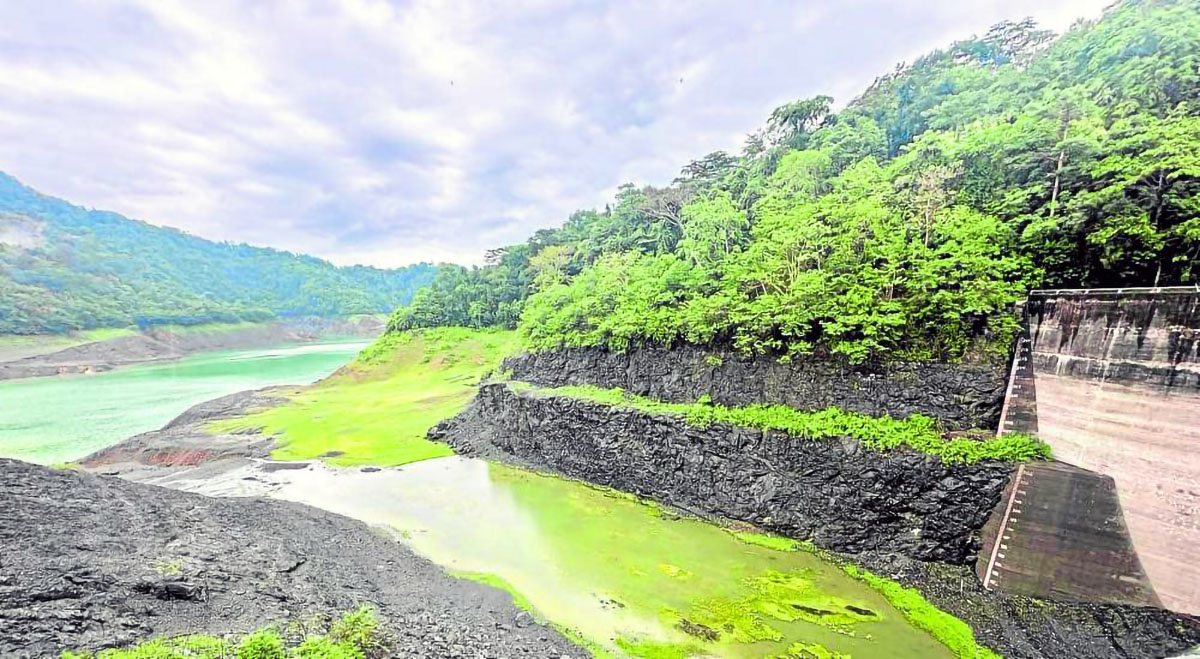Recent rains slow decline of Angat Dam’s level

DWINDLING The two-layered elevation gauge of Angat Dam indicates that its water level is far below the normal high water mark of 212 meters above sea level in this photo taken on June 5. This part of the reservoir leads to the spillway. —Carmela Reyes-Estrope
CITY OF MALOLOS, BULACAN, Philippines — Strong intermittent rains over the past three weeks have slowed the drop in Angat Dam’s water level, preventing it from falling significantly below its minimum operating mark of 180 meters above sea level (masl).
On Tuesday, the reservoir was at 178.08 masl, which was a slight increase from the 178.05 masl on Monday evening when heavy rainfall was experienced in Angat watershed, according to the Bulacan Provincial Disaster Risk Reduction Management Office (PDRRMO).
READ: Angat Dam down to 180-meter minimum operating water level
Since the last week of May, the reservoir’s level has stayed above 178.00 masl, reaching 179.04 masl on June 3 at the onset of the rainy season.
The first drop below the dam’s operating level was recorded on May 23 at 179.68 masl, falling from the 180.7 masl recorded the previous day.
According to the PDRRMO, the reservoir’s normal high water level is 212.00 masl.
It said the depletion in water level was primarily due to the absence of rain, particularly during the recent summer season influenced by the El Niño phenomenon. The dam, located in Norzagaray town of Bulacan, supplies most of the water needs of Metro Manila, powers a hydro-electric plant and irrigates about 28,000 hectares of farms, mostly rice fields, in Bulacan and Pampanga provinces.Monitoring
Lawrence Nipales, chief of the Angat Hydroelectric Power Plant reservoir and water waste division, told reporters during a June 5 visit to the reservoir that the dam’s depleting water level could no longer be monitored by the facility’s sensor and now requires continuous manual monitoring by security team members.
“The elevation is now manually monitored because our sensor can no longer read below the 180-masl low operating level. The sensor can still read at 190.00 masl,” Nipales said.
Nipales said the dam has undergone a 4-meter expansion on the crest and a 20-meter strengthening of the lower base in slope position to withstand the feared 7.2-magnitude earthquake, known as “The Big One.”
He also dismissed recent reports that El Niño has caused cracks in the dam.
“It is not true that there will be cracks because it is an earth-rock-filled dam. It will just be shaken and become more compact. It becomes more compacted if it shakes or experiences water shaking,” Nipales said.
Angat Hydro uses both modern and conventional systems for typhoon and flood warning and forecasting to operate more accurately and efficiently during rainy and typhoon seasons, he noted.Communication
In addition to weekly inspections of the facilities and various dam instruments, Nipales said they maintain a multi-communication process with the PDRRMO and other major stakeholders, especially concerning dam releases.
According to PDRRMO chief Manuel Lukban Jr., this communication process involves dialing the direct number of the PDRRMO Operation Center in the City of Malolos.
He said the landline phone connection between the two offices is crucial for advisories on the timing and volume of water discharges.
Apart from the direct line, Lukban added that spill-out advisories could also be communicated through email, fax, and teleconferencing.
Dam-related advisories and warnings are also disseminated to 10 towns along the Angat River through a fleet of 15 small vehicle dispatch teams.
Angat hydrologist Mark Aguilar said that they operate 27 rain gauge stations and 17 warning stations in the towns of Norzagaray and Angat.
Lukban added that they also conduct text blasts to inform the public if Angat Dam, along with the Ipo and Bustos dams, will release water.